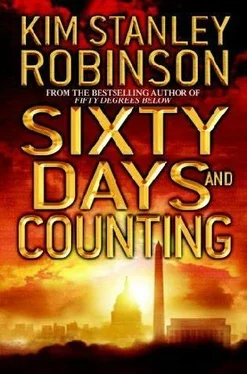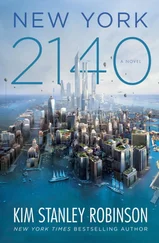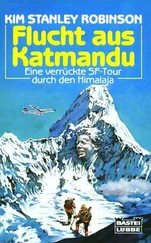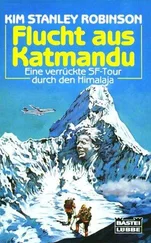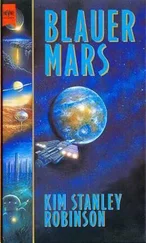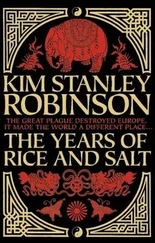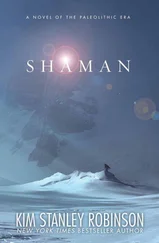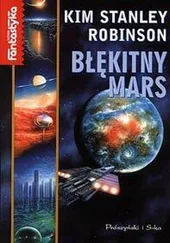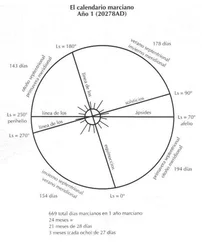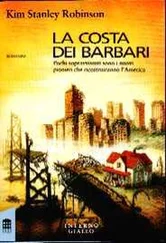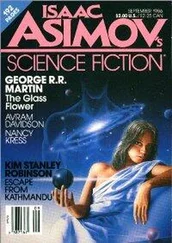After dinner the Maxfield Parrish blues of the twilight gave way to the stars, and then the Milky Way. The moon would not rise for a few hours, and in the starlight they could still see the strange tongue of low cloud, now gray, licking the north wall of the basin. The lake beside them stilled to a starry black mirror. Quickly the cold began to press on the little envelopes of warmth their clothes created, and they slid into their sleeping bags and continued to watch the tiny stove-pellet fire that Dave kept going, feeding it from time to time with the tiniest of twigs and pine needles.
The conversation wandered, and sometimes grew ribald. Dave was outlining an all-too-convincing biological basis for the so-called midlife crisis, and general confessions of inappropriate lust for young women were soon augmented by one or two individual case studies of close calls, at work or in the gym. Laughter in the dark, and some long silences too.
Voices by starlight. But it’s stupid. It’s just your genes making one last desperate scream when they can feel they’re falling apart. Programmed cell death. Apoptosis. They want you to have more kids to up their chance of being immortal, they don’t give a shit about you or your actual happiness or anything.
If you’re just fooling around, if you don’t mean to leave your wife and go with that person, then it’s like masturbating in someone else’s body.
Yuck! Jesus, yuck!
Hoots of horrified hilarity, echoing off the cliffs across the lake. That’s so gross I’ll never again be able to think about having an affair!
So I cured you. So now you’re old. Your genes have given up.
My genes will never give up.
The little stove pellet burned out. The hikers went quiet and were soon asleep, under the great slow wheel of the stars.
The next day they explored the Lakes Basin, looking into a tributary of it called the Dumbbell Basin, and dropping to the Y-shaped Triple Falls on Cartridge Creek, before turning back up toward the head of the basin proper. It was a beautiful day, the heart of the trip, just as it was the heart of the pluton, and that pluton the heart of the Sierra itself. No trails, no people, no views out of the range. They walked on the heart of the world.
On such days some kind of freedom descended on them. Mornings were cold and clear, spent lazing around their sleeping bags and breakfast coffee. They chatted casually, discussed the quality of their night’s sleep. They asked Charlie about what it was like to work for the president: Charlie gave them his little testimonial. “He’s a good guy,” he told them. “He’s not a normal guy, but he’s a good one. He’s still real. He has the gift of a happy temperament. He sees the funny side of things.” Frank listened to this closely, head cocked to one side.
Once they got packed up and started, they wandered apart, or in duos, catching up on the year’s news, on the wives and kids, the work and play, the world at large. Stopping frequently to marvel at the landscapes that constantly shifted in perspective around them. It was very dry, a lot of the fellfields and meadows were brown, but the lakes were still there and their borders were green as of old. The distant ridges; the towering thunderheads in the afternoons; the height of the sky itself; the thin cold air; the pace of the seconds, tocking at the back of the throat; all combined to create a sense of spaciousness unlike any they ever felt anywhere else. It was another world.
But this world kept intruding.
Their plan was to exit the basin by way of Cartridge Pass, which was south of Vennacher Col, on the same border ridge of the pluton. This pass had been the original route for the Muir Trail; the trail over it had been abandoned in 1934, after the CCC built the replacement trail over Mather Pass. Now the old trail was no longer on the maps, and Troy said the guidebooks described it as being gone. But he didn’t believe it, and in yet another of his archeological quests, he wanted to see if they could relocate any signs of it. “I think what happened was that when the USGS did the ground check for their maps in 1968, they tried to find the trail over on the other side, and it’s all forest and brush over there, so they couldn’t pick it up, and they wrote it off. But over on this side there’s nothing but rock up near the top. I don’t believe much could happen to a trail up there. Anyway I want to look.”
Vince said, “So this is another cross-country pass, that’s what you’re saying.”
“Maybe.”
So once again they were on the hunt. They hiked slowly uphill, separating again into their own spaces. “ ‘Now I know you’re not the only starfish in the sea!’ Starfish? How many other great American songs are about starfish, I ask you? ‘Yeah, the worst is over now, the morning sun is rising like a red, rubber ball !’”
Then on the southeast slope of the headwall, where the maps showed the old trail had gone, their shouts rang out once more. Right where one would have hiked if one were simply following the path of least resistance up the slope, a trail appeared. As they hiked up, it became more and more evident, until high on the headwall it began to switchback up a broad talus gully that ran up between solid granite buttresses. In that gully the trail became as obvious as a Roman road, because its bed was made of decomposed granite that had been washed into a surface and then in effect cemented there by years of rain, without any summer boots ever breaking it up. It looked like the nearly concretized paths that landscapers created with decomposed granite in the world below, but here the raw material had been left in situ and shaped by feet. People had only hiked it for some thirty or forty years—unless the Native Americans had used this pass too—and it was another obvious one, and near Taboose, so maybe they had—in which case people had hiked it for five or ten thousand years. In any case, a great trail, with the archeological component adding to the sheer physical grandeur of it.
“There are lost trails like this on an island in Maine,” Frank remarked to no one in particular. He was looking around with what Charlie now thought of as his habitual hiking expression. It seemed he walked in a rapture.
The pass itself gave them long views in all directions—north back into the basin, south over the giant gap of the Muro Blanco, a granite-walled canyon. Peaks beyond in all directions.
After a leisurely lunch in the sun, they put on their packs and started down into the Muro Blanco. The lost trail held, thinning through high meadows, growing fainter as they descended, but always still there.
But here the grass was brown. This was a south-facing slope, and it almost looked like late autumn. Not quite, for autumn in the Sierra was marked by fall colors in the ground cover, including a neon scarlet that came out on slopes backlit by the sun. Now that same ground cover was simply brown. It was dead. Except for fringes of green around drying ponds, or algal mats on the exposed pond bottoms, every plant on this south-facing slope had died. It was as burnt as any range in Nevada. One of the loveliest landscapes on the planet, dead before their eyes.
They hiked at their different paces, each alone on the rocky rumpled landscape. Bench to bench, terrace to terrace, graben to graben, fellfield to fellfield, each in his own private world.
Charlie fell behind the rest, stumbling from time to time in his distress, careless of his feet as his gaze wandered from one little ecodisaster to the next. He loved these high meadows with all his heart, and the fellfields between them too. Each had been so perfect, like works of art, as if hundreds of meticulous bonsai gardeners had spent centuries clipping and arranging each water-course and pad of moss. Every blade of grass deployed to best effect, every rock in its proper place. It had never occurred to Charlie that any of it could ever go away. And yet here it was, dead.
Читать дальше
Конец ознакомительного отрывка
Купить книгу
